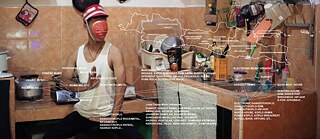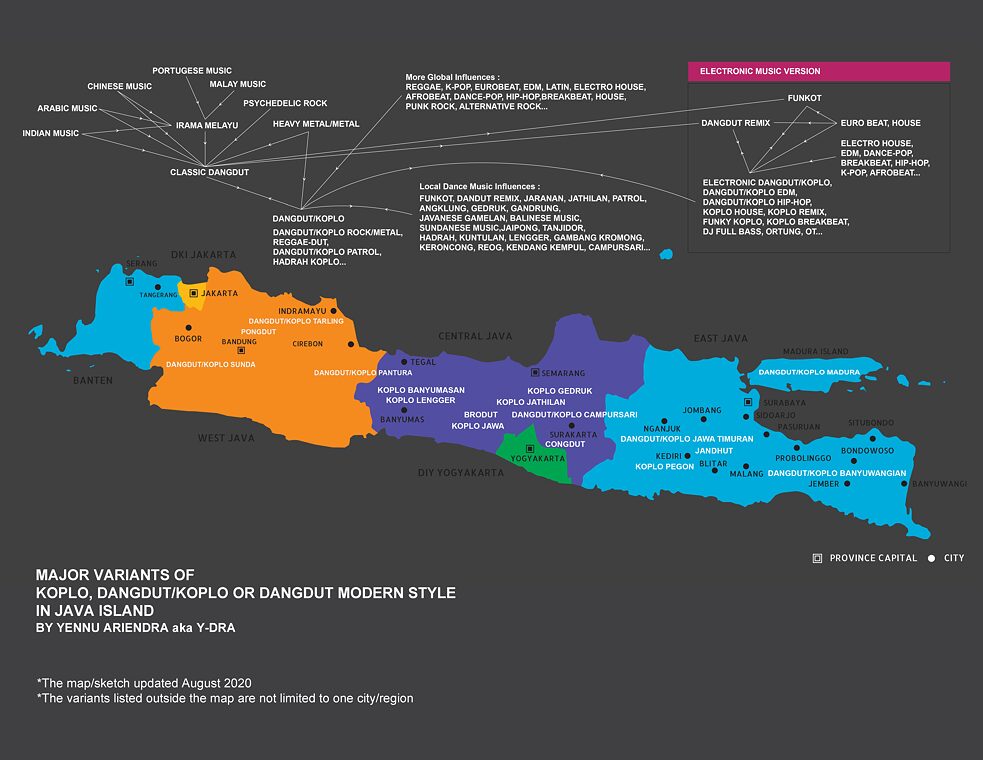
20 Years of Celebrating Dystopia in Java - Part 2
By Yennu Ariendra, 2020Koplo in North Java
Another distinctive regional dangdut koplo is from the northern coast of Java. In this case, the term pantura (an abbreviation of »pantai utara,« meaning north coast) refers not only to coastal Java, but more specifically to the border region between West and Central Java. Dangdut artists from this region are frequently featured on the popular national TV contest, Bintang Pantura. The main genre of koplo in this region is known as koplo tarling.Dangdut tarling is based around the incorporation of tarling folk melodies. Tarling is an abbreviation of the words »gitar« (guitar) and »suling« (flute). When I was in Indramayu in West Java in 2010, koplo tarling was at its peak. I had the fortune of seeing artists such as Aas Rolani and Dewi Kirana, who is known as »The Queen of Pantura.« I was even able to see her sing classic songs such as »Mabok Bae« and »Mujaer Mundur.«
Mapping Dangdut Koplo
Other variations of dangdut koplo continue to emerge in other parts of Java. In West Java, dangdut koplo artists mix dangdut with jaipong; this style has become known as jaipong dangdut or pongdut. In Yogyakarta, where I am currently based, you can find koplo jawa, koplo campursari, and congdut (from »keroncong dangdut«). Koplo gedruk and koplo jatilan are two emerging variants of koplo found in this region as well.My feeling is that it is increasingly difficult to find traditional arts in Java as virtually all of them have become contemporary. Even in the case of ritualistic wayang kulit (shadow puppet) performance, we often find elements of dangdut koplo, hip hop, and house music. While many parts of the traditional form change, its essence does not. As such, it is impossible to create a fixed map of the highly diverse and divergent genres of popular art forms, including dangdut koplo.
I have nonetheless attempted to map koplo, dangdut koplo, or modern dangdut. The map was last updated in April 2020 and it will require constant updating. Indeed, Wikipedia is yet to have an entry for every kind of koplo that can be found on YouTube. As I have explained earlier, the terms do not just refer to a genre or subgenre of music, but can be interpreted as a beat or just an idea.
 Major Variants of koplo, dangdut koplo or dangdut modern style on the island of Java. |
Major Variants of koplo, dangdut koplo or dangdut modern style on the island of Java. |
Celebrating Sadness on the Koplo Stage
Koplo lyrics aren’t so different from dangdut lyrics. They make use of everyday vocabulary. While classic dangdut has now come to be identified with beautiful and romantic lyrics, koplo has returned to the genre’s original idea; telling brief stories of marginalized communities, failed love stories due to class difference, as well as the ordeals of migrant workers.The song, »Kimcil Kepolen« (An Over-the-Top Girl), by NDX AKA tells the love story of a girl whose mother wants her daughter to be with a man who at the very least rides a Kawasaki Ninja motorbike. Class divisions are sharply divided in Indonesia and the wage gap between that of a laborer and a foreman is immense. In the song, »Juragan Empang,« a girl tells of her happiness due to being admired by the owner of a fish pond. In villages or cities, poverty is something real. Young women dream about marrying a rich man or, at least, being able to work in Hong Kong, Saudi Arabia, or Malaysia. Many get jobs as workers in factories, as maids, and sometimes also as sex workers, often underage. Dangdut koplo songs also include stories about domestic violence and the abuse of drugs and alcohol.
Many dangdut koplo songs tell stories about suffering and life’s many difficulties. These stories are, however, accompanied by cheerful melodies, and lively, harsh, and wild music. Dangdut koplo audiences enjoy the songs gleefully, dancing until they forget themselves, as if all their suffering and sadness is just a joke, something to be celebrated.
Many dangdut koplo songs tell stories about suffering and life’s many difficulties. These stories are, however, accompanied by cheerful melodies, and lively, harsh, and wild music. Dangdut koplo audiences enjoy the songs gleefully, dancing until they forget themselves, as if all their suffering and sadness is just a joke, something to be celebrated.
What is actually happening here? Is this a kind of sarcastic or satirical drama? Or, is it planned, deliberate, constructed? Is it because people feel as if they no longer have any hope? Or is it just a means with which to acknowledge life’s bitter realities? After all, the grassroot or lower classes are often forgotten in governmental policies. They are treated as second class citizens who don’t deserve a voice. Politics in Indonesia is reserved for the elite and middle classes.
I asked numerous people in the dangdut koplo scene whether their lyrics are politically motivated or if they are deliberately being satirical. They replied that there are no such intentions.
But there is a long tradition of cultural resistance in Javanese culture, from the colonial era until the present. Dangdut koplo continues the practices of earlier forms of cultural resistance.
There are numerous models of protest art amongst the grassroots. They do not state their political aspirations in a clear and succinct manner. Their »honesty« (kejujuran) is conveyed through symbolic expression, the use of metaphor, and satirical jokes. For many Javanese, understanding the intentions of symbols and metaphors comes easily as a result of culture and habit. History is written into myths and fortune-telling. Time is not framed in a linear fashion.
»Honesty« is something that can become a political weapon. I once asked a friend of mine: »what is the measure of success of cultural resistance in the Indonesian context?« My friend replied that it was »ignorance.« In this case, ignorance was interpreted as being the absence of public trust in the government. In Indonesia’s history, numerous governments have been brought down by grassroots movements. For example, the Soeharto government was brought down thanks to a collective oppositional movement, a strong student movement, and the ignorance of the masses, who had become incensed at the government and all of its mendacity.
Grassroots groups are able to consolidate their strength as a kind of army, or they can serve as supporters of a particular regime. The Soeharto government was maintained through its ability to control the grassroots. The government was able to devise the scenario of a civil war. The different classes were played off against each other in the name of the anti-communist movement. The government’s plan was to sideline its enemies; those who were critical of the government and who had the potential to challenge it. They did so through mobilising the grassroots to act in their name.
It is no surprise that dangdut and other popular art forms can be used for advancing political interests. During the New Order era, 1966–98 (I was a child throughout much of this time), it was common to see dangdut performances where lots of people wore Golkar paraphernalia (Golkar was the vehicle of President Soeharto’s party). At wayang kulit performances, Soeharto was depicted as »the father of development« and the »saviour of the people.« As already stated, the majority of the Indonesian population is a part of the grassroots, and thus it is not difficult how these messages and symbols could be used to garner support for the ruling power. Similar strategies are still being used today as a means to consolidate power.
This might be clear to some members of the grassroots. In Java, expressions of cultural resistance are evident in metaphors and various symbolic acts and even jokes, perhaps because they know that it might not be possible to win the battle in a direct manner. Cultural resistance might be something simple and not necessarily having a direct outcome, but on a broad scale it might be able to initiate significant change.
Conclusion
Dangdut koplo has yet to initiate significant change in society, but it has the potential to do so. Or, is this a misguided idea? Perhaps it has already significantly influenced Indonesia’s socio-political condition, and I have yet to realise it.In the context of activism, is it important whether or not dangdut koplo is recognised as one of the biggest (politically powerful) music scenes in Southeast Asia, or the world? The scene doesn’t need such recognition. Dangdut koplo has a comfortable home amongst the grassroots of Indonesia’s population of 250 million people, which is more than a third of the 600 million people of Southeast Asia.
Dangdut koplo has made a world for itself. I don’t think its fans care if their music is considered to be marginal music, some kind of joke, worthless, or if it is not even on the global music map. They live on a different planet; they live in a future which we have yet to comprehend.Of course, this is all based on my assumption that dangdut koplo is a form of contemporary cultural resistance.
However, what is certain is that dangdut koplo is dystopian; it is a world which has been created through disappointment and celebrated by brightly lit parties.
In conclusion, here is a compilation of dangdut koplo to get you dancing.